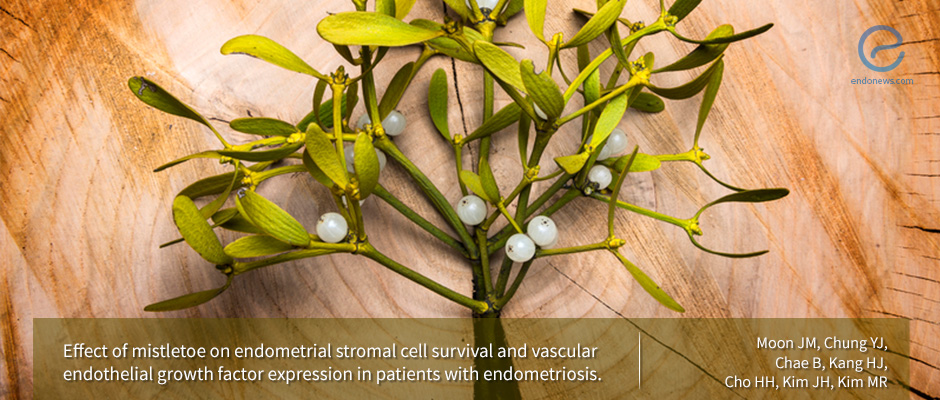Mistletoe as a Potential Candidate for Endometriosis Treatment
Feb 5, 2019
Mistletoe might have anti-angiogenic activity on endometrial stromal cells
Key Points
Highlight:
- Dr. Kim from South Korea suggests that mistletoe might have anti-angiogenic activity, and could be considered as an immune modulator for the treatment of early or recurrent endometriosis.
Background:
- Some investigators suggest that the peritoneum of endometriosis patients is attributed to a pro-inflammatory environment, and various kinds of inflammatory cytokines and angiogenic factors such as VEGF, IL-1ß, and IL-6 are related to the development and progression of endometriosis.
- It has been reported that the increased VEGF is one of the key factors which promote transplantation of ectopic endometrial tissue.
- Mistletoe is a semi-parasitic plant, grows attached to a wide range of host trees. It stimulates and normalizes the immune system, so the growth of ectopic cells inhibited without killing normal cells. Moreover, Helixor A, a type of mistletoe, has been reported to be effective in treating cancers and some other diseases including endometriosis.
- In this study, Dr. Kim group determine if the mistletoe regulates the level of VEGF, and the anti-angiogenic effect of mistletoe could be used in the treatment of endometriosis.
Key results:
- Forty women with endometriosis (stage I/II [n=20], stage III/IV [n=20])and 20 women with benign gynecologic diseases (the control group) were selected.
- Endometrial stromal cells and peritoneal fluid were collected and cultured directly from both eutopic and ectopic endometrium of ovarian endometriomas (experimental group) and treated with the peritoneal fluid or mistletoe.
- Both eutopic and ectopic endometrial stromal cell viability increased after treatment with peritoneal fluid from patients with early-stage (I and II) endometriosis.
- After mistletoe treatment, the cell viability was decreased in both eutopic and ectopic endometrial stromal cells in all stages of endometriosis.
- The group found that increased VEGF expression in peritoneal fluid decreased after mistletoe treatment.
Lay Summary
Endometriosis, one of the common benign gynecologic disorders, is defined as the ectopic presence of endometrial cells outside of the uterine cavity. Although the underlying mechanisms are not fully understood, the most accepted hypothesis is that endometrial cells pass through retrograde menstrual flow and implant in the abdominal cavity.
Some investigators suggested that peritoneum of endometriosis patients might attribute a pro-inflammatory environment, promoting the occurrence of endometriosis. Among various kinds of molecules which are related to the development and progression of endometriosis, vascular endothelial growth factor (VEGF) is well-known to promote transplantation of ectopic endometrial tissue.
Mistletoe is a semi-parasitic plant that grows attached to a wide range of host trees and shown to stimulate the immune system. Helixor A, a type of mistletoe, has been reported to be effective in treating cancers and other diseases including endometriosis. However, the effect of mistletoe in endometriosis is not well-studied. In this study, Dr. Kim group determine if the mistletoe regulates the level of VEGF, and the anti-angiogenic effect of mistletoe could be used in the treatment of endometriosis.
In order to test the effect of mistletoe on endometriosis, twenty women with benign gynecologic diseases were selected as the control group and forty women with endometriosis were designated as the experimental group (stage I/II [n=20], and stage III/IV [n=20]).
Endometrial stromal cell viability was measured after peritoneal fluid or mistletoe treatment. Both eutopic and ectopic cell viability increased after treatment with peritoneal fluid from patients with early-stage (I and II) endometriosis. After mistletoe treatment, however, the cell viability was decreased in all stages of endometriosis. By performing Western blot and ELISA, VEGF expression was increased upon treatment with peritoneal fluid and then decreased when mistletoe was treated.
In conclusion, researchers found that the peritoneal fluid in the early stage of endometriosis had specific factors increasing cell viability and VEGF expression, and this effect decreased after mistletoe treatment. Based on this finding, Dr. Kim group suggests that mistletoe could be considered as an immune modulator for the treatment of early or recurrent endometriosis.
Research Source: https://www.ncbi.nlm.nih.gov/pubmed/?term=30443175
Endometriosis Endometrial stromal cell Mistletoe Vascular endothelial growth factor IL-1ß IL-6 pro-inflammatory

